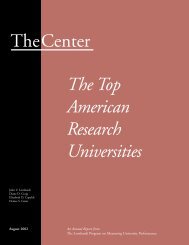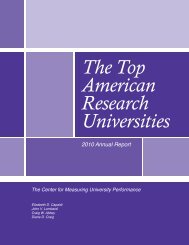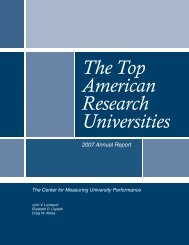The Top American Research Universities - The Center for ...
The Top American Research Universities - The Center for ...
The Top American Research Universities - The Center for ...
Create successful ePaper yourself
Turn your PDF publications into a flip-book with our unique Google optimized e-Paper software.
<strong>The</strong> <strong>Top</strong> <strong>American</strong> <strong>Research</strong> <strong>Universities</strong><br />
report both. We selected the test which has the greatest percentage<br />
of students reporting. To convert ACT scores scores, we use a<br />
conversion table provided by <strong>The</strong> College Board to generate a<br />
comparable SAT equivalent score. When an institution submits<br />
neither an SAT nor ACT score, we substitute data from other national<br />
data sources.<br />
Other Measures of Undergraduate Quality<br />
National Merit and Achievement Scholars<br />
Source: <strong>The</strong> 2006-07 National Merit Scholarship Corporation<br />
Annual Report, which reflects the 2007 freshman class.<br />
<strong>The</strong> National Merit Scholarship Corporation (NMSC) is an<br />
independent, nonprofit organization that awards scholarships to<br />
the nation’s outstanding high school seniors based on their academic<br />
achievement, qualifying test scores, high school principal<br />
and counselor recommendations, and their activities, interests,<br />
and goals. <strong>The</strong> NMSC names approximately 16,000 National<br />
Merit Finalists each February. Of these, about one-half will<br />
receive a National Merit $2,500 Scholarship, a corporatesponsored<br />
scholarship, or a college-sponsored scholarship.<br />
National Achievement Scholars are selected and funded in a<br />
similar fashion and represent the nation’s outstanding African-<br />
<strong>American</strong> students. Ideally, the National Hispanic Scholars Program<br />
should also be included in this category, but it does not track<br />
the enrollment of its scholarship winners. Should it do so in the<br />
future, we will include these students in <strong>The</strong> <strong>Center</strong>’s data. In this<br />
study, Merit and Achievement scholarships are credited to the<br />
main campus if the NMSC Annual Report does not indicate a<br />
branch campus.<br />
While the number of National Merit and National Achievement<br />
award winners in the entering class provides an indication of the<br />
attractiveness of a university’s undergraduate program to outstanding<br />
students, it is also an indicator that is sensitive to institutional<br />
policies on financial aid. Because the number of Merit<br />
Scholars is small, relatively small changes in institutional aid<br />
policies can have a significant impact on the number of National<br />
Merit Scholars enrolling in institutions. <strong>The</strong> average SAT score<br />
provides a broader-based and more reliable measure of overall<br />
undergraduate quality; <strong>for</strong> those reasons, we prefer the SAT scores<br />
to the number of National Merit and Achievement Scholars as an<br />
indicator of undergraduate quality.<br />
Institutional Characteristics<br />
Medical Schools<br />
Source: NCES IPEDS Completions Survey, MD degrees awarded<br />
between July 1, 2006, and June 30, 2007.<br />
Although the IPEDS Institutional Characteristics Survey does<br />
have a “medical” field that indicates whether an institution grants<br />
a medical degree, we choose not to use its data because it includes<br />
medical degrees in Veterinary Medicine, Dentistry, and other professional<br />
health-related fields. For our measure, we determined<br />
whether a particular campus awarded any MD degrees during the<br />
academic year. If the institution did not submit any data to IPEDS<br />
<strong>for</strong> that year, we then looked at whether it was accredited by the<br />
<strong>American</strong> Medical Association to determine whether the institution<br />
has a medical school.<br />
Land Grant Institutions<br />
Source: National Association of State <strong>Universities</strong> and Land Grant<br />
Colleges.<br />
<strong>The</strong> first Morrill Act in 1862 appropriated federal funds <strong>for</strong><br />
universities to provide agricultural and technical education to their<br />
citizens. A second Morrill Act in 1890 expanded eligibility to<br />
include several historically black colleges and universities, and<br />
in 1994 several Native <strong>American</strong> tribal colleges were recognized<br />
as land grant institutions. Today, there is at least one land grant<br />
institution in each state and U.S. territory and in the District of<br />
Columbia. Of the 105 institutions, most are public universities.<br />
Federal land grant institutions receive both federal and state<br />
dollars in support of their agricultural and extension activities.<br />
While land grant status technically applies to some university<br />
systems, such as the University of Cali<strong>for</strong>nia and the University<br />
of Nebraska, <strong>for</strong> our study we designate as land grant institutions<br />
only those schools that actually per<strong>for</strong>m that function (e.g., UC-<br />
Berkeley, UC-Davis, UC-Riverside, Nebraska-Lincoln). In these<br />
cases, the land grant field will identify whether an institution is<br />
part of a system-wide land grant and whether the vast majority<br />
of the activity occurs on that campus. For example, UC-Davis is<br />
coded as “Yes-System” while UCLA is coded as “No-System.”<br />
We consider the 1890 institutions as land grant institutions, but we<br />
identify them separately because they do not per<strong>for</strong>m extension<br />
activities.<br />
<strong>Research</strong> Focus<br />
NSF/SRS Survey of R&D Expenditures at <strong>Universities</strong> and<br />
Colleges, FY 2006.<br />
In addition to reporting expenditure data by source of funds,<br />
NSF identifies in what major disciplines the money is expended.<br />
In the <strong>Research</strong> by Discipline table we provide the proportion of<br />
total and federal expenditures in each discipline <strong>for</strong> those institutions<br />
with more than $40 million in federal research. <strong>The</strong>se data<br />
are useful <strong>for</strong> developing groups of similar institutions <strong>for</strong> peer<br />
analysis.<br />
<strong>The</strong> Institutional Characteristics table provides a summary<br />
measure of an institution’s research strength and concentration<br />
based on these discipline-level expenditures. <strong>Universities</strong> with<br />
95-100% of their federal research dollars spent in one particular<br />
2008 Annual Report<br />
215








